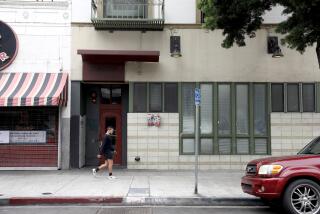G&L; Adjusting to Life as a Public Property
Medical office developer Daniel M. Gottlieb says he is building a strong company by following the rules of real estate. But, judged by the ways of Wall Street, he and his firm may be headed for trouble, industry observers say.
“The money is going out and not coming in,” said Craig Silvers, a securities analyst who follows real estate stocks for Sutro & Co. “They are going to be buried deeper and deeper [in trouble].”
The clash between Silvers and Gottlieb--who is chief executive and co-chairman of Beverly Hills-based G&L; Realty Corp., a real estate investment trust--partly reflects the differences that can result when privately owned real estate firms go public.
The transition from private to public suddenly finds real estate managers having to defend longtime company relationships and industry practices. Wall Street’s obsession with quarterly results is a major irritant for real estate veterans accustomed to working on projects that take months if not years to start generating cash. Many are not accustomed to the public scrutiny and second-guessing when a company’s results fall short.
“It’s part of the trade-off,” said Gottlieb, who was involved in real estate for about 20 years before assuming the job of running a publicly traded company. “I don’t make any secrets of what we do.”
In the case of G&L;, concerns have been raised about business dealings between the company, which owns and operates about 40 medical office and senior housing facilities nationwide, and members of its board of directors. In addition, the firm’s quarterly dividend has remained unchanged despite a prolonged slump that has reduced earnings.
Gottlieb co-founded G&L; Realty in 1976 with Steven D. Lebowitz, president and co-chairman. For many years, the company was focused on buying and constructing medical office buildings in Beverly Hills. In December 1993, the firm raised $84 million when it went public. Since it went public, G&L; Realty--one of the nation’s smaller REITs--has suffered numerous setbacks, including the 1994 Northridge earthquake, which damaged many of its properties. Last year, its single-largest tenant--PHP Health Care, which occupied six buildings in New Jersey--filed for bankruptcy.
These and other factors have certainly taken a toll on G&L;’s earnings. Including one-time charges, G&L;’s funds from operations--a common measure of a REIT’s financial performance--plunged to $800,000 in 1998 from $8.4 million in the previous year. Results in the first quarter of 1999 were also down substantially.
On Monday, G&L;’s stock price closed unchanged at $12.06 on the New York Stock Exchange.
Yet G&L; has not reduced its dividend despite the fact that its funds from operation have either failed or barely been sufficient to cover the dividend in the last several quarters. For example, in the first quarter of this year, the dividend remained at 39 cents a share while funds from operations only generated 23 cents a share.
“It’s not sustainable,” said one real estate consultant. “They will end up running out of cash.
“The dividend is far too high,” Silvers said.
Ironically, it was Silvers’ company, Sutro & Co., that helped underwrite a $77-million issue of preferred stock by G&L.; Silvers says that G&L; was slow to use the cash to develop new properties. As a result, the company is now in the middle of paying for a substantial amount of new construction that will not begin generating revenue until next year at the earliest, compounding its financial woes.
Gottlieb concedes his company may have been slow to use the proceeds for development. But real estate development takes time, from identifying promising markets to buying property and finally leasing the space. His company remains confident that its new developments will eventually boost profits and support the dividend.
“I know the values are there,” said Gottlieb, who, along with president Steven D. Lebowitz, owns about 30% of the company’s stock. “One should take a longer view instead of [focusing] on what you are doing in the quarter.”
Securities analysts and investors also take a dim view of business dealings between companies and their boards of directors. In many private real estate firms, however, it’s not uncommon for members of the board or partners to sell or lease properties or make loans to the firm. But such relationships raise suspicions among securities analysts and shareholders concerned about conflicts of interest.
Earlier this year, for example, G&L; disclosed that it had borrowed $2 million at 12% from director Reese L. Milner as part of a short-term loan that has been repaid. It also sold a vacant property to a firm owned by director S. Craig Tompkins for $1.6 million. The company has the option to buy back the property but at an ever-increasing price--which will rise by 3% a month beginning February 2000.
Gottlieb says the financial terms of the deals are much better than if G&L; borrowed the money from a lender. In the option to buy back the property from Tompkins, the 3% monthly rate hike--or 36% a year--is a penalty and one the company plans to avoid, he said. In both cases, the outside members of the board of directors reviewed and approved the transactions.
“Having money available to you can be a very expensive proposition,” Gottlieb said. “I’ll get it from the cheapest source.”
The industry has tried to avoid such transactions to head off the credibility problems it suffered when it began in the 1970s, said Ralph Block, who follows REITs for Bay Isle, a San Francisco-based investment advisor.
“It’s not the kind of thing that the REIT investor likes to see . . . even if it’s a fair deal,” Block said. “It really becomes impossible to know whether the company has essentially made a sweetheart deal with the directors and executives.”
More to Read
Inside the business of entertainment
The Wide Shot brings you news, analysis and insights on everything from streaming wars to production — and what it all means for the future.
You may occasionally receive promotional content from the Los Angeles Times.










